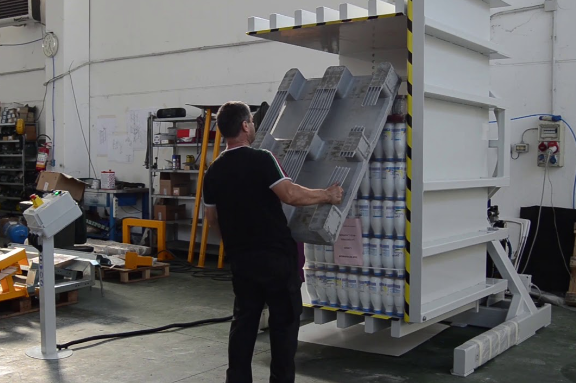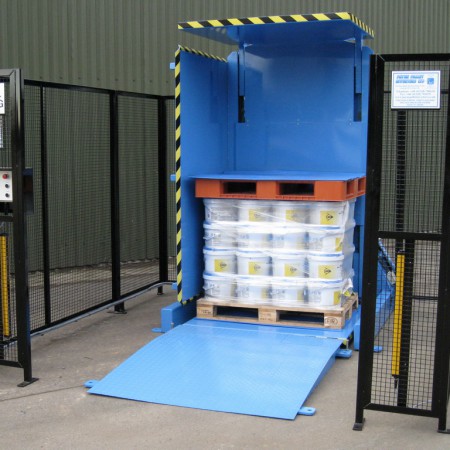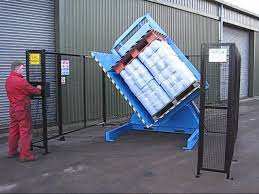Pallet Inverter: What’s the Most Efficient Way to Rotate Empty Carton Pallets?
Are you watching your operational costs climb? You've likely tackled the big ones, like energy and raw materials. But small, repetitive tasks are silently draining your resources. Manual handling of empty carton pallets, for instance, seems minor. However, it introduces safety risks, creates bottlenecks, and eats into your labor budget every single day. I've seen this hidden inefficiency cripple the output of even the most sophisticated factories. There is a much better way to handle this, a solution that transforms this cost center into a streamlined part of your operation.
The most efficient method for rotating empty carton pallets is using a dedicated machine called a pallet inverter. This equipment automates the entire process by securely clamping a stack of pallets and rotating it 180 degrees. This eliminates the need for manual labor, drastically cuts down on handling time, and significantly reduces the risk of injury or damage to the pallets themselves.

This solution might sound like just another piece of equipment to add to your capital expenditure list. But as an engineer who has spent over 25 years on factory floors, first as an employee and now as a factory owner myself, I can assure you it's a strategic investment. It’s a decision that pays for itself through improved safety, speed, and efficiency. Let's explore why this seemingly simple machine can have such a profound impact on your operations, especially in a demanding environment like a steel mill.
Why is Manual Pallet Rotation a Hidden Cost in Your Steel Mill?
You meticulously track the big-ticket items. You know your energy consumption down to the kilowatt-hour and your material costs to the cent. But what about the small, recurring tasks performed by your team every day, like flipping empty pallets? These activities often fly under the radar on financial reports. They become "just part of the job." This is a costly mistake. This manual work is a significant hidden cost, draining your budget, introducing unnecessary risks, and slowing down your entire logistics chain. By bringing these costs into the light, you can uncover a powerful opportunity for savings.
Manual pallet rotation is a major hidden cost because it directly translates into wasted labor hours, a higher risk of workplace injuries, damage to your pallets, and operational bottlenecks that disrupt the smooth flow of your production line. Every minute your team spends wrestling with pallets is a minute not spent on value-adding activities.

A Deeper Look at the Hidden Costs
As someone who has built a business from the ground up, I am obsessed with efficiency. I learned early on that the small, overlooked costs are the ones that can prevent a good business from becoming a great one. Let's break down the real costs of manual pallet handling.
The True Cost of Manual Labor
The most obvious cost is labor. Let's do some simple math. Suppose it takes two workers five minutes to manually unstack, flip, and restack a set of empty pallets. If this happens just 12 times a day, that's one full hour of labor for two people. Over a year, that's hundreds of hours of skilled labor spent on a low-value, high-risk task. This is time your team could be using for quality control, inventory management, or preparing shipments—activities that directly contribute to your bottom line.
| Cost Factor | Manual Handling | Impact on Operations |
|---|---|---|
| Labor Time | 5-10 minutes per stack | Hundreds of wasted man-hours per year. |
| Injury Risk | High (back strain, splinters) | Increased insurance premiums, lost workdays, potential legal costs. |
| Pallet Damage | Moderate to High | Increased replacement costs, operational delays from unusable pallets. |
| Efficiency | Creates Bottlenecks | Slows down loading/unloading, holds up forklifts and personnel. |
The Unseen Financial Drain of Safety Risks
A steel mill is an environment where safety is paramount. Manual pallet handling is an ergonomic nightmare. It involves awkward lifting, bending, and twisting, which are leading causes of musculoskeletal injuries, especially back injuries. A single serious injury can cost tens of thousands of dollars in medical bills, lost productivity, and increased insurance premiums. It's a risk you don't need to take. A pallet inverter contains the process within a safe, guarded machine, virtually eliminating the physical strain on your employees.
The Ripple Effect on Your Entire Operation
Think of your operation as a chain. A weak link, no matter how small, compromises the strength of the entire chain. Manual pallet handling is a weak link. When a forklift driver has to wait for pallets to be manually prepared, a loading bay becomes congested. This delay can ripple backward, causing finished goods to pile up and potentially even slowing down the production line itself. You have a goal to increase uptime to 95%. You can't achieve that if your logistical processes are inefficient and unreliable.
How Can a Pallet Inverter Boost Your Operational Efficiency?
Your goal of hitting 95% equipment uptime is ambitious and admirable. But as we both know, overall plant efficiency isn't just about your main production lines. It's the sum of every process, big and small. A slow, manual task in your warehouse can create a delay that forces your expensive production equipment to sit idle. You simply cannot achieve peak uptime if your internal logistics can't keep pace. A pallet inverter is a tool that directly attacks these logistical bottlenecks. It helps create the smooth, fast, and predictable workflow you need to support your primary production goals.
A pallet inverter boosts operational efficiency by dramatically cutting the cycle time for pallet exchange. It frees up your skilled workers for more critical tasks. It also minimizes damage to products and pallets, and it improves the overall workflow in your shipping and receiving areas.

A Deeper Look at Efficiency Gains
When I was growing my own factory, I faced a similar challenge. My production machines were fast, but my packing and shipping areas were struggling to keep up. I realized that to grow, I had to optimize the entire process, not just the core manufacturing steps. Investing in automation for these supporting tasks was a game-changer.
From Minutes to Seconds: A Time-Based Transformation
Let's look at the process. Manually rotating a stack of pallets requires a forklift to bring the stack, two workers to unstack them one by one, flip them, and then restack them. This process is slow, variable, and takes at least 5 minutes. Now, compare that to a pallet inverter. A forklift places the entire stack into the machine. The operator pushes a button. In less than 60 seconds, the machine clamps, rotates, and releases the perfectly flipped stack, ready for the forklift to take away.
| Process Step | Manual Method (Approx. 5-10 min) | Pallet Inverter Method (Approx. 60 sec) |
|---|---|---|
| Preparation | Clear space, position workers | Forklift places stack in machine |
| Execution | Unstack, flip, restack each pallet | Operator pushes a button; machine rotates |
| Completion | Restack and secure the load | Forklift removes the rotated stack |
| Result | Inconsistent, labor-intensive | Fast, consistent, automated |
This isn't just a small time-saver. It's a fundamental change in your workflow. This new speed and predictability allow you to schedule your logistics with the same precision as your production lines.
Redeploying Your Workforce Strategically
This efficiency gain has a direct impact on your goal to reduce operating costs. You are no longer paying skilled workers to do a physically demanding, low-value job. That same employee who was flipping pallets can now be retrained to perform quality control inspections, manage shipping documents, or operate another piece of machinery. You are elevating the role of your workforce, making them more valuable to your organization and improving their job satisfaction. This is how you reduce labor costs smartly, not by cutting staff, but by optimizing their contribution. The pallet inverter doesn't replace workers; it empowers them.
What Key Features Should You Look for in a Pallet Inverter for Your Industry?
You've seen the potential benefits and are considering a pallet inverter. That’s a great first step. But not all machines are created equal, especially when they need to survive in a demanding environment like your steel mill. You know from your experience with aging equipment that making the right choice upfront is critical. Choosing the wrong machine could mean it can't handle your loads, it breaks down constantly, or it lacks the essential safety features your team needs. A poor investment is often worse than no investment at all.
For a heavy industrial environment like a steel mill, the key features to look for in a pallet inverter are a high load capacity, robust all-steel construction, comprehensive safety systems like light curtains and physical guarding, and controls that are intuitive and easy to integrate with your existing operational flow.

A Deeper Look at Industrial-Grade Features
As an engineer, I love getting into the details of machinery. The difference between a machine that lasts two years and one that lasts twenty is in the engineering and the quality of the components. When I advise clients like you, I tell them to think about the machine's life, not just its initial price.
Durability and Load Capacity are Non-Negotiable
Your environment is tough on equipment. Dust, temperature fluctuations, and heavy usage take their toll.
- Construction: Look for a machine built with heavy-gauge steel. Check the quality of the welds. A robust frame is the foundation of a long-lasting machine.
- Load Capacity: Don't just meet your maximum pallet weight; exceed it. I recommend a capacity rating that is at least 25% higher than your heaviest expected load. This safety margin reduces stress on the hydraulic and mechanical components, leading to a longer service life and preventing failures when an unexpectedly heavy pallet comes through.
- Hydraulics and Motor: The power system is the heart of the machine. Ask about the brand of the hydraulic pump and motor. Reputable, industrial-grade components are easier to service and far more reliable than generic alternatives.
Critical Safety Mechanisms for Your Team
For a leader like you, the safety of your people is always the top priority. A modern pallet inverter should come with a multi-layered safety system.
- Guarding: The machine should be enclosed in physical safety fencing to prevent anyone from accidentally entering the operational area while it's moving.
- Light Curtains: These create an invisible barrier of light at the entrance to the machine. If a person or object breaks the barrier while the machine is active, it stops immediately. This is a crucial feature for preventing accidents.
- Pressure-Sensitive Plates: Some advanced models have floor plates that can detect if a person is standing within the operating zone, providing another layer of protection.
- Emergency Stops: These should be clearly visible and easily accessible from all sides of the machine.
| Feature | Why It Matters for a Steel Mill | My Recommendation |
|---|---|---|
| Heavy-Gauge Steel Frame | Resists wear and tear in a tough environment. | Insist on seeing specifications for steel thickness. |
| 25%+ Overrated Capacity | Ensures longevity and prevents system failure. | Calculate your max load and choose the next model up. |
| Full Safety Guarding | Prevents accidental entry during operation. | This should be a standard, non-negotiable feature. |
| Integrated Light Curtains | Provides active, intelligent operator protection. | The most effective safety feature for open-entry points. |
How Does a Pallet Inverter Fit into a Digitally Transformed Warehouse?
I see you are a forward-thinking leader. You are pushing for a full digital transformation with MES, IoT sensors, and big data analysis. That is exactly the right path for a modern industrial operation. So you might be asking, "Vincent, how does a 'simple' machine like a pallet inverter fit into this high-tech vision?" It's a fair question. It's easy to focus on the software and platforms and forget about the physical machinery. But here is what I’ve learned: if your physical processes are not automated and efficient, your digital systems will only be good at tracking and highlighting inefficiencies you can't solve.
A pallet inverter fits into a digitally transformed warehouse by acting as a reliable, automated physical node. It can be integrated with your Warehouse Management System (WMS) or MES to receive commands, report its status and cycle times, and provide clean data that confirms the physical completion of a logistical task. It bridges the gap between your digital plan and your physical reality.

My Insight: Building Your Smart Factory from the Ground Up
Javier, I see your goals: increase产能利用率 to 95%, reduce能耗 by 10%, and lower运营成本 by over 8%. These are the marks of a sharp, competitive leader. My own journey, from working on the factory floor to owning a successful factory, taught me a fundamental lesson: operational excellence is built by systematically eliminating small, recurring wastes. Digital transformation is not just about a fancy dashboard; it's about using technology to attack these wastes with precision.
The "Last Mile" of Automation
Your MES and ERP systems are brilliant for planning. They tell you what needs to happen and when. But they rely on your physical operations to execute that plan. If the plan says "prepare 20 pallets for shipment," and that process is manual, slow, and unpredictable, the entire digital plan suffers. The pallet inverter becomes an automated tool that executes a specific command from your WMS/MES. The system can send a signal to perform a pallet swap, and the machine does it perfectly every time. This is the "last mile" of automation, where digital instruction becomes physical action.
Data You Can Actually Trust
One of the biggest challenges in implementing big data analytics is getting clean, reliable data from the factory floor. Manual processes generate messy data. How long did it take to flip the pallets? "About five minutes." That's not data; that's a guess. An automated pallet inverter provides a clean, consistent data point. The cycle time is always, for example, 47 seconds. You now have a reliable metric. You can track throughput accurately. You can predict logistics timing with confidence. Your digital model becomes a more accurate reflection of reality because it's built on a foundation of reliable, automated physical processes.
A Stepping Stone to a Smarter Future
When I was building my own business, I couldn't afford to automate everything at once. I started with the tasks that created the biggest bottlenecks and offered the highest return on investment. For many operations, a pallet inverter is exactly that—a low-hanging fruit. It's a relatively simple investment that delivers immediate, measurable results in safety, speed, and labor savings. It proves the value of automation to your team and your stakeholders. This success builds momentum for your larger digital transformation goals, creating a culture of continuous improvement and paving the way for future investments in technologies like AGVs or robotic palletizing systems. It's a smart, strategic first step on the path to the fully automated, data-driven facility you envision.
Conclusion
Investing in a pallet inverter is more than a simple equipment purchase. It's a strategic move to eliminate waste, enhance safety, and build a more efficient, data-driven foundation for your operations.


